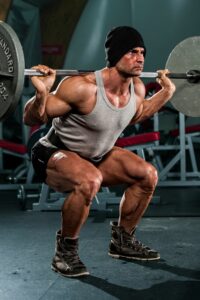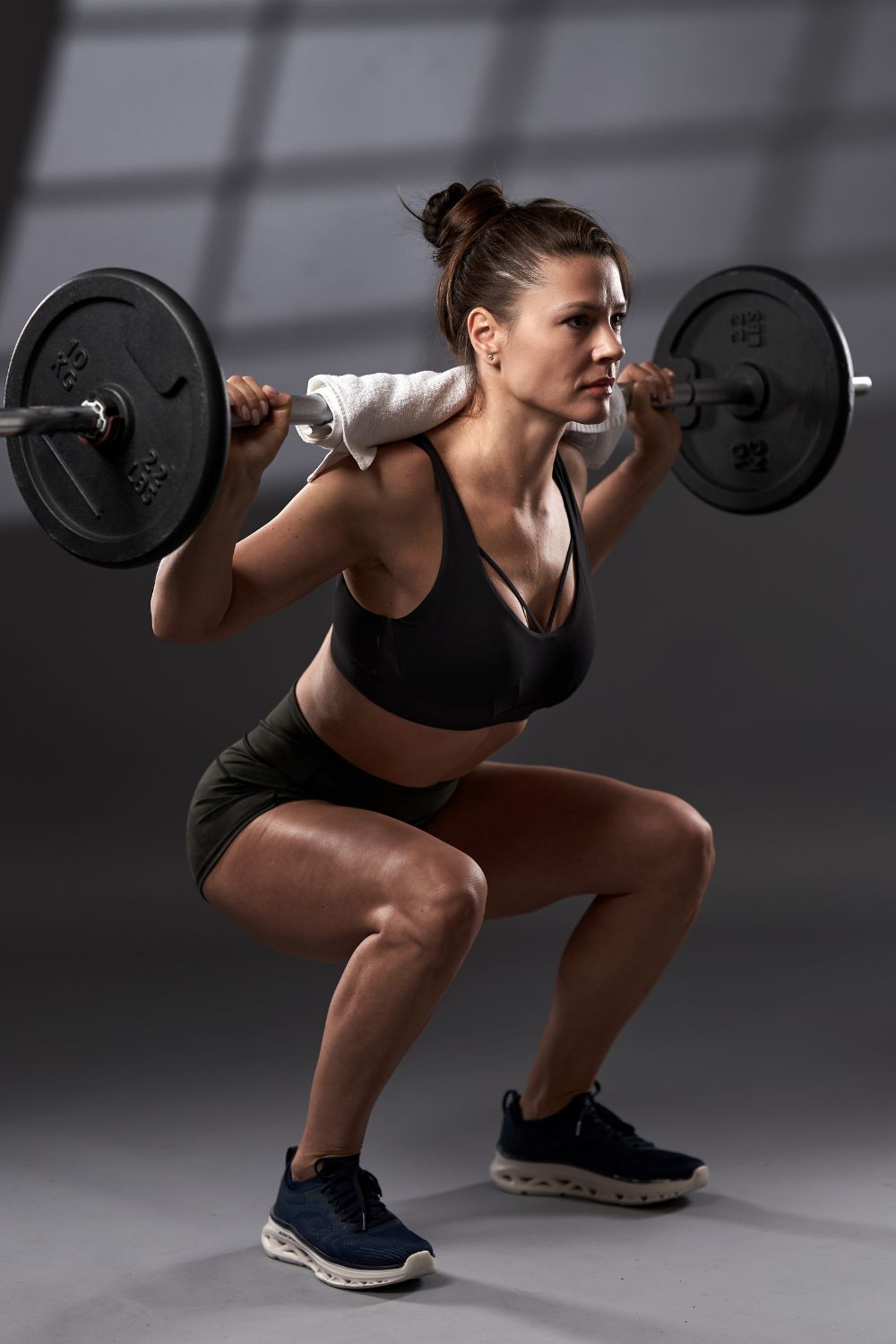When you think of squats, what’s the first thing that comes to mind? Most likely, it’s an image of someone with a barbell on their shoulders, working on their leg muscles. While squats are indeed a fantastic exercise for building strong and shapely legs, they offer a plethora of benefits that extend far beyond just leg day. In this comprehensive guide, we’ll delve into the multifaceted advantages of squats, debunk some common myths, and discuss their relevance in your overall fitness routine. Whether you’re a fitness enthusiast or a beginner looking to learn more, this article is your ultimate resource.
The Power of Squats
Squats are a versatile compound exercise that engages multiple muscle groups and provides a broad range of benefits. Before we explore these advantages in detail, let’s establish the primary muscles involved in the squat:
Quadriceps
The quadriceps, often referred to as the “quads,” are a group of four muscles located in the front of your thighs. Squats target these muscles, helping to develop strength and definition in the upper leg area.
Hamstrings
The hamstrings, located on the back of your thighs, work in conjunction with the quads during squats. They provide stability and balance, contributing to the overall effectiveness of the exercise.
Glutes
Squats are renowned for their ability to sculpt and strengthen the gluteal muscles, creating a more toned and lifted appearance.
Calves
Though not as prominent, the calf muscles play a supporting role in maintaining balance during squats.
Core
Your core muscles are engaged to stabilize your spine and maintain proper posture throughout the squatting motion.
Lower Back
The lower back muscles play a critical role in supporting the spine and preventing injury during squats.
Now that we’ve identified the key muscles involved in squats let’s explore the comprehensive benefits they provide:
1. Leg Strength and Muscle Growth
Target Keyword: Leg Strength
As the most obvious benefit, squats are a fantastic way to build leg strength. Regular squatting can lead to increased muscle mass in the quadriceps, hamstrings, and glutes. Stronger legs not only enhance your physical appearance but also improve your overall functionality, making daily activities easier and more enjoyable.

2. Improved Athletic Performance
Squats for Athletic Performance
Squats are a staple in most athletes’ training routines for a good reason. By strengthening the muscles used in various sports, squats can help improve athletic performance. Whether you’re a runner, a basketball player, or a soccer enthusiast, squats can enhance your speed, power, and agility.
3. Enhanced Balance and Coordination
Balancing Act: How Squats Improve Stability
Squatting engages your core, lower back, and stabilizing muscles, leading to improved balance and coordination. This can be particularly beneficial as you age, as balance is crucial in preventing falls and injuries.
4. Increased Bone Density
Squats and Bone Health
Weight-bearing exercises like squats stimulate bone growth and increase bone density. This is vital for maintaining strong and healthy bones, which is especially important as you get older.
5. Efficient Calorie Burn
Squats for Weight Loss
Squats are a powerful calorie-burning exercise, making them a valuable addition to any weight loss or fat-burning regimen. The compound nature of squats means you work multiple muscle groups at once, leading to a higher calorie expenditure.
6. Enhanced Posture and Spine Health
Squats and Good Posture
Proper squatting technique requires maintaining an upright posture. Regular practice can lead to better posture and reduced risk of lower back pain. The engagement of the core and lower back muscles also contributes to spine health.
7. Versatile and Convenient
The Convenience of Squats
Squats are one of the most versatile exercises you can do. They require minimal equipment, making them suitable for home workouts or the gym. Plus, they can be modified to suit your fitness level and goals.
8. Hormonal Benefits
Squats and Hormonal Health
Strength training exercises like squats can boost the production of growth hormone and testosterone, both of which play a role in muscle growth and overall well-being.
9. Mental Toughness
Building Mental Resilience Through Squats
Squats can be physically challenging, and conquering them can build mental toughness and resilience. The sense of accomplishment after completing a challenging squat session is incredibly satisfying.
Now that we’ve explored the multifaceted benefits of squats, it’s time to address a common misconception:
Myth: Squats Are Only for Leg Muscles
Many people believe that squats exclusively target the legs. While they are indeed an excellent exercise for leg development, squats are a full-body workout that engages a variety of muscle groups. This makes them a valuable addition to any fitness routine, regardless of your specific goals.
As we’ve discussed earlier, squats work the quads, hamstrings, glutes, calves, core, and lower back. In essence, they are a compound exercise that recruits muscles from head to toe. By focusing solely on the leg aspect of squats, you’d be missing out on the opportunity to strengthen and tone other critical areas of your body.
How to Incorporate Squats into Your Fitness Routine
Now that we’ve highlighted the holistic benefits of squats, you may be wondering how to incorporate them into your fitness routine effectively. Here are some tips to get you started:
1. Learn Proper Form
Before you load up the barbell or grab a dumbbell, it’s essential to master proper squat form. This will ensure that you’re targeting the right muscles and reducing the risk of injury. Consider seeking guidance from a fitness professional or using online tutorials to learn the correct technique.
2. Start with Bodyweight Squats
If you’re new to squats or returning to exercise after a break, it’s wise to begin with bodyweight squats. This allows you to focus on your form and build a solid foundation before adding additional resistance.
3. Gradually Increase the Resistance
As you become more comfortable with bodyweight squats, you can start incorporating weights. You can use a barbell, dumbbells, or kettlebells to add resistance and challenge your muscles further.
4. Mix Up Your Squat Variations
Squats come in various forms, such as back squats, front squats, goblet squats, and pistol squats. Experiment with different variations to keep your workouts exciting and target your muscles from various angles.
5. Include Squats in Your Full-Body Workouts
To maximize the benefits of squats, incorporate them into your full-body workout routine. This will help you achieve a balanced physique and prevent overemphasis on certain muscle groups.
6. Stay Consistent
Like any exercise, consistency is key. Aim to include squats in your routine at least two to three times a week for optimal results.
Common Squat Mistakes to Avoid
To reap the full benefits of squats and prevent injury, it’s crucial to avoid common mistakes. Here are some errors to watch out for:
1. Poor Form
Incorrect form can lead to injuries and negate the benefits of squats. Ensure your knees don’t go beyond your toes, keep your back straight, and maintain a stable core throughout the movement.
2. Neglecting Warm-Up and Cool-Down
Skipping warm-up and cool-down exercises can increase the risk of injury. Always prepare your muscles with a warm-up and help them recover with a cool-down.
3. Lifting Too Much Weight
Attempting to lift too much weight can compromise your form and lead to injury. Gradually increase the resistance to avoid this common mistake.
4. Neglecting Mobility and Flexibility
Squats require good hip and ankle mobility. Neglecting these aspects can limit your range of motion and hinder your squat performance.
5. Not Listening to Your Body
If you experience pain or discomfort during squats, it’s essential to listen to your body. Pushing through pain can lead to injuries, so be mindful of any warning signs.
Conclusion
In conclusion, squats are a dynamic exercise that offers a wide range of benefits beyond just leg strength. They are a full-body workout that can improve your athletic performance, balance, bone density, calorie burn, posture, and more. While they are excellent for developing leg muscles, it’s crucial to recognize their holistic advantages and incorporate them into your fitness routine accordingly.
So, the next time you hear someone say, “Squats are only for legs,” you can confidently share the comprehensive benefits of this versatile exercise. Embrace squats as a valuable addition to your fitness journey and unlock their potential to transform your body and overall well-being. Start squatting today and experience the transformative power of this remarkable exercise.
A comparison tabular on this
Here’s a comparison table that summarizes the key points about the benefits of squats:
| Benefit of Squats | Description |
|---|---|
| Leg Strength | Squats are excellent for building strength in the quadriceps, hamstrings, and glutes. |
| Improved Athletic Performance | Enhances speed, power, and agility, making them valuable for athletes in various sports. |
| Enhanced Balance and Coordination | Engages core muscles, improving balance and coordination, especially important as you age. |
| Increased Bone Density | Weight-bearing squats stimulate bone growth and enhance bone density for stronger bones. |
| Efficient Calorie Burn | Squats are a powerful calorie-burning exercise, aiding in weight loss and fat burning. |
| Enhanced Posture and Spine Health | Maintaining upright posture during squats can lead to better posture and spine health. |
| Versatile and Convenient | Suitable for home workouts or the gym, and can be modified to suit your fitness level. |
| Hormonal Benefits | Strength training with squats can boost growth hormone and testosterone for muscle growth. |
| Mental Toughness | Challenging squats can build mental resilience, offering a sense of accomplishment. |
This table provides a quick and easy-to-read summary of the benefits of squats, helping readers grasp the key points at a glance.
Final words
In the world of fitness and strength training, squats reign as a true powerhouse exercise. While they are often associated with leg day, they offer so much more. Squats are a holistic, full-body workout that can bring about a transformation in various aspects of your physical and mental well-being.
From building leg strength and improving athletic performance to enhancing balance, bone density, and posture, squats have something to offer everyone. They are a versatile, convenient, and calorie-burning exercise that can be adapted to your fitness level and goals. Moreover, the mental resilience and sense of accomplishment that come with conquering squats make them a rewarding addition to your fitness routine.
So, the next time you hear someone claim that squats are only for legs, you can confidently debunk that myth and share the comprehensive benefits of this remarkable exercise. Embrace squats as a valuable companion on your fitness journey, and experience the positive impact they can have on your body and overall well-being.
Don’t limit yourself to leg day – squat your way to a stronger, healthier, and more confident you. Start squatting today and unlock the transformative power of this exercise. Your body and mind will thank you for it.

Hey there, it’s Mike Rrsq, the Editor-in-Chief over at Jsquat.com, and I’m absolutely obsessed with all things squat fitness! I’ve been lucky enough to get some serious recognition for my work in this field. With a solid background in the fitness and wellness industry, I’ve been there right from the get-go, helping shape this website into what it is today.
You see, I’m not just the boss around here; I’m also a passionate contributor. I love sharing my insights through my articles, and trust me, they’re not your run-of-the-mill stuff. Each piece I write is a labor of love, filled with my expertise and real-world experience in the fitness universe. So, if you’re into fitness and looking for some inspiration, you’re in the right place!

